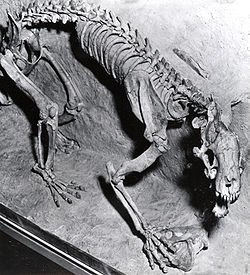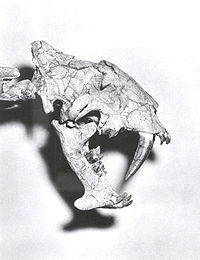- Nimravidae
-
Nimravidae
Temporal range: 37–5 Ma Early Eocene - Late Miocene
Hoplophoneus mentalis Conservation status FossilScientific classification Kingdom: Animalia Phylum: Chordata Class: Mammalia Order: Carnivora Suborder: Feliformia Family: †Nimravidae Subfamilies - †Nimravinae
- †Hoplophoninae
The Nimravidae, sometimes known as false saber-toothed cats, are an extinct family of mammalian carnivores belonging to the suborder Feliformia and endemic to North America, Europe, and Asia living from the Eocene through the Miocene epochs (42—7.2 mya), existing for approximately 34.8 million years.[1]
Contents
Morphology
Although some nimravids physically resembled the sabre-toothed cats of genus Smilodon, they were not closely related, but evolved a similar form through parallel evolution. Previously classified as a subfamily of Nimravidae, the barbourofelids have been recently reassigned to their own distinct family Barbourofelidae (Morlo et al. 2004).[2]
The ancestors of nimravids and felids diverged from their common ancestor, from the Caniformia-Feliformia split, in the middle Eocene about 50 million years ago (mya), with a minimum constraint of 43 mya. Recognizable nimravid fossils date from the late Eocene (37 mya), from the Chadronian White River Formation at Flagstaff Rim, Wyoming, to the late Miocene (5 mya). Nimravid diversity appears to have peaked about 28 mya. Most had muscular, low-slung, catlike bodies, with shorter legs and tails than typical of cats.
Taxonomy
Nimravidae was named by Cope (1880). Its type is Nimravus. It was assigned to Fissipedia by Cope (1889); to Caniformia by Flynn and Galiano (1982); to Aeluroidea by Carroll (1988); to Feliformia by Bryant (1991); and to Carnivoramorpha; by Wesley-Hunt and Werdelin (2005).[3][4]
Nimravids are placed in tribes by some authors to reflect closer relationships in genera within the family. Some nimravids did evolve into large toothed cat-like forms with massive flattened upper canines and accompanying mandibular flanges. Others had dentition similar to felids, or modern cats, with smaller canines. Others had moderately increased canines in a more intermediate relationship between the saber-toothed cats and felids. The upper canines were not only shorter, but also more conical, than those of the true saber-toothed cats. These are referred to as being False sabre-tooths.
Not only did nimravids exhibit diverse dentition but they also showed the same diversity in size and morphology as felids. Some were leopard-sized, others the size of today's lions and tigers, and one had the short face, rounded skull and smaller canines of the modern cheetah.
Natural history
Nimravids appeared in the late Eocene epoch, about 37 mya, in North America and Asia. The global climate in the middle Eocene had been warm and wet, but in the late Eocene was trending towards cooler and drier. The lush forests of the Eocene were transitioning to scrub and open woodland. This climatic trend continued in the Oligocene, and nimravids evidently flourished in this environment. North America and Asia were connected by the Bering Land Bridge and shared much related fauna. Europe in the Oligocene was more an archipelago than a continent, though some land bridges must have existed, for Nimravids spread there, as well.
In the Miocene, the fossil record suggests many animals suited for forest or woodland were replaced by grazers suited for living in grasslands, so evidently much of North America and Asia became dominated by savanna. Nimravids disappeared along with the woodlands, but survived in relictual humid forests in Europe to the late Miocene. When conditions ultimately changed there in the late Miocene, the last nimravids disappeared about 9 mya.[5]
Classification
- Family: Nimravidae
- Subfamily Nimravinae
- Genus: Dinictis
- Genus: Dinaelurus
- Genus: Dinailurictis
- Genus: Eofelis
- Genus: Nimravus
- Genus: Pogonodon
- Genus: Quercylurus
- Subfamily Hoplophoninae
- Genus: Eusmilis
- Genus: Hoplophoneus
- Subfamily Nimravinae
References
- ^ PaleoBiology Database: Nimravidae, basic info
- ^ Zoological Journal of the Linnean Society, Volume 140 Issue 1 Page 43 - January 2004
- ^ E. D. Cope. 1889. Synopsis of the families of Vertebrata. The American Naturalist 23:1-29
- ^ J. J. Flynn and H. Galiano. 1982. Phylogeny of early Tertiary Carnivora, with a description of a new species of Protictis from the middle Eocene of northwestern Wyoming. American Museum Novitates.
- ^ Prothero, Donald R. (2006). After the Dinosaurs: The Age of Mammals. Bloomington, Indiana: Indiana University Press. pp. 9, 132–134, 160, 174, 176, 198, 222–233. ISBN 9780253347336.
- Zoological Journal of the Linnean Society, 2003, 138, 477–493
- A new species of Prosansanosmilus: implications for the systematic relationships of the family Barbourofelidae new rank (Carnivora, Mammalia)
Categories:- Nimravids
- Saber-toothed cats
Wikimedia Foundation. 2010.


